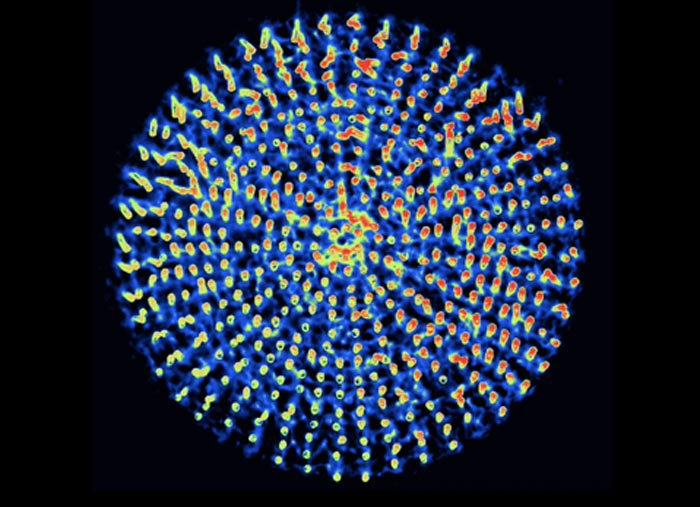Self-propelled, endlessly programmable artificial cilia

The microstructures in a radially arranged microarray , as seen here, can perform complex traveling waves of locally interacting posts .
Credit: Joanna Aizenberg/Harvard SEAS
Simple microstructures that bend, twist and perform stroke-like motions could be used for soft robotics, medical devices and more.
For years, scientists have been attempting to engineer tiny, artificial cilia for miniature robotic systems that can perform complex motions, including bending, twisting, and reversing. Building these smaller-than-a-human-hair microstructures typically requires multi-step fabrication processes and varying stimuli to create the complex movements, limiting their wide-scale applications.
Now, researchers from the Harvard John A. Paulson School of Engineering and Applied Sciences (SEAS) have developed a single-material, single-stimuli microstructure that can outmaneuver even living cilia. These programmable, micron-scale structures could be used for a range of applications, including soft robotics, biocompatible medical devices, and even dynamic information encryption.
The research is published in Nature.
“Innovations in adaptive self-regulated materials that are capable of a diverse set of programmed motions represent a very active field, which is being tackled by interdisciplinary teams of scientists and engineers,” said Joanna Aizenberg, the Amy Smith Berylson Professor of Materials Science and Professor of Chemistry & Chemical Biology at SEAS and senior author of the paper. “Advances achieved in this field may significantly impact the ways we design materials and devices for a variety of applications, including robotics, medicine and information technologies.”
Unlike previous research, which relied mostly on complex multi-component materials to achieve programmable movement of reconfigurable structural elements, Aizenberg and her team designed a microstructure pillar made of a single material — a photoresponsive liquid crystal elastomer. Because of the way the fundamental building blocks of the liquid crystal elastomer are aligned, when light hits the microstructure, those building blocks realign and the structure changes shape.
As this shape change occurs, two things happen. First, the spot where the light hits becomes transparent, allowing the light to penetrate further into the material, causing additional deformations. Second, as the material deforms and the shape moves, a new spot on the pillar is exposed to light, causing that area to also change shape.
This feedback loop propels the microstructure into a stroke-like cycle of motion.
“This internal and external feedback loop gives us a self-regulating material. Once you turn the light on, it does all its own work,” said Shucong Li, a graduate student in the Department of Chemistry and Chemical Biology at Harvard and co-first author of the paper.
When the light turns off, the material snaps back to its original shape.
The material’s specific twists and motions change with its shape, making these simple structures endlessly reconfigurable and tunable. Using a model and experiments, the researchers demonstrated the movements of round, square, L- and T-shaped, and palm-tree-shaped structures and laid out all the other ways the material can be tuned.
“We showed that we can program the choreography of this dynamic dance by tailoring a range of parameters, including illumination angle, light intensity, molecular alignment, microstructure geometry, temperature, and irradiation intervals and duration,” said Michael M. Lerch, a postdoctoral fellow in the Aizenberg Lab and co-first author of the paper.
To add another layer of complexity and functionality, the research team also demonstrated how these pillars interact with each other as part of an array.
“When these pillars are grouped together, they interact in very complex ways because each deforming pillar casts a shadow on its neighbor, which changes throughout the deformation process,” said Li. “Programming how these shadow-mediated self-exposures change and interact dynamically with each other could be useful for such applications as dynamic information encryption.”
“The vast design space for individual and collective motions is potentially transformative for soft robotics, micro-walkers, sensors, and robust information encryption systems,” said Aizenberg.
The paper was co-authored by James T. Waters, Bolei Deng, Reese S. Martens, Yuxing Yao, Do Yoon Kim, Katia Bertoldi, Alison Grinthal and Anna C. Balazs. It was supported in part by the U.S. Army Research Office, under grant number W911NF-17-1-0351 and the National Science Foundation through the Harvard University Materials Research Science and Engineering Center under award DMR-2011754.
Journal: Nature
DOI: 10.1038/s41586-022-04561-z
Media Contact
Leah Burrows
Harvard John A. Paulson School of Engineering and Applied Sciences
lburrows@seas.harvard.edu
Office: 617-496-1351
Media Contact
All latest news from the category: Materials Sciences
Materials management deals with the research, development, manufacturing and processing of raw and industrial materials. Key aspects here are biological and medical issues, which play an increasingly important role in this field.
innovations-report offers in-depth articles related to the development and application of materials and the structure and properties of new materials.
Newest articles

Innovative 3D printed scaffolds offer new hope for bone healing
Researchers at the Institute for Bioengineering of Catalonia have developed novel 3D printed PLA-CaP scaffolds that promote blood vessel formation, ensuring better healing and regeneration of bone tissue. Bone is…

The surprising role of gut infection in Alzheimer’s disease
ASU- and Banner Alzheimer’s Institute-led study implicates link between a common virus and the disease, which travels from the gut to the brain and may be a target for antiviral…

Molecular gardening: New enzymes discovered for protein modification pruning
How deubiquitinases USP53 and USP54 cleave long polyubiquitin chains and how the former is linked to liver disease in children. Deubiquitinases (DUBs) are enzymes used by cells to trim protein…



